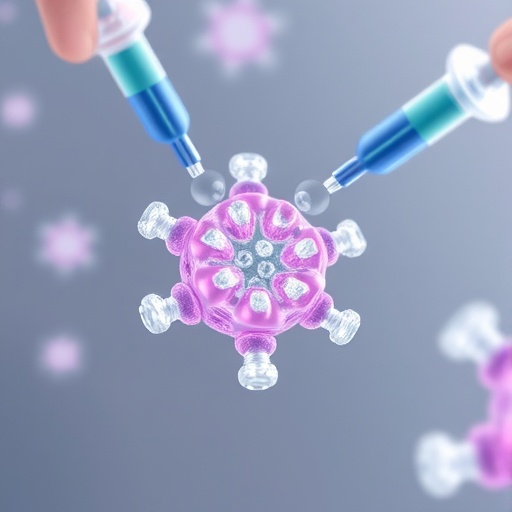
In a groundbreaking development set to transform the landscape of drug delivery, researchers have engineered a novel class of self-aggregating long-acting injectable microcrystals that promise to radically extend the duration and efficacy of therapeutics administered via injection. This innovative approach leverages the unique physicochemical properties of microcrystalline formulations, which spontaneously aggregate post-injection to create localized drug depots capable of controlled, sustained release. Published in Nature Chemical Engineering, the work by Feig, Park, Rivano, and colleagues heralds a new frontier in pharmacokinetics, where drug release profiles can be finely tuned to optimize therapeutic outcomes over extended periods, potentially reducing dosing frequency and improving patient compliance.
The core of this advancement lies in the self-assembling behavior of the engineered microcrystals. Unlike conventional sustained-release formulations that rely on biodegradable polymers or encapsulation within microspheres, these microcrystals exploit intrinsic molecular interactions to spontaneously aggregate once injected into physiological environments. This aggregation forms stable, compact depots that gradually dissolve or erode, systematically releasing the active pharmaceutical ingredient. The ability to bypass polymer carriers sidesteps issues such as inflammatory responses or unpredictable degradation kinetics, which have historically complicated the design of long-acting injectables.
Key to achieving this feat was meticulous control over the crystallization process during formulation development. By tailoring parameters such as solvent composition, supersaturation levels, and nucleation rates, the research team generated microcrystals with precise morphologies and surface chemistries that favor self-recognition and aggregation under physiological ionic strengths and pH conditions. This tunability enables the customization of depot characteristics—including size, mechanical stability, and dissolution kinetics—thus providing a versatile platform adaptable to a wide array of drugs with differing solubility and stability profiles.
Mechanistically, the microcrystals exhibit a delicate balance of electrostatic, van der Waals, and hydrogen bonding forces that govern their assembly post-injection. Upon exposure to body fluids, ionic interactions are screened, allowing hydrophobic patches on the crystal surfaces to promote adhesion and cluster formation. This event transforms the dispersed microcrystals into a cohesive mass that anchors within the surrounding tissue, drastically slowing drug diffusion into systemic circulation. Such controlled spatial confinement not only prolongs therapeutic presence but also minimizes initial burst release phenomena, often a challenge with many sustained-release formulations.
The implications for chronic disease management are profound. Conditions requiring strict therapeutic windows—such as HIV, diabetes, or psychiatric disorders—stand to benefit immensely from decreased injection frequencies. For patients, reduced dosing burdens translate into enhanced adherence, fewer clinic visits, and improved quality of life. Clinicians gain a powerful tool to maintain stable plasma drug levels, thereby reducing side effects linked to dosing fluctuations and improving overall treatment efficacy.
Further innovation comes from the platform’s compatibility with a broad spectrum of drug classes, from small molecules to biologics. The team demonstrated this versatility by incorporating various therapeutics into the microcrystals without compromising their self-assembly properties. This adaptability opens avenues to address unmet medical needs where long-acting formulations are currently lacking or inadequate. Moreover, the crystalline nature of the depot supports the incorporation of drugs sensitive to enzymatic degradation, extending the stability and half-life in vivo.
From a manufacturing standpoint, the process leverages scalable crystallization techniques amenable to industrial pharmaceutical production. This contrasts favorably with complex polymer encapsulation processes that often require multiple steps, specialized equipment, and stringent quality controls. The relative simplicity in producing injectable microcrystals augurs well for cost-effective production and rapid clinical translation.
Safety profiles assessed in preclinical models reveal minimal local tissue irritation or immune activation, a vital consideration for injectables intended for chronic administration. The crystalline depots gradually dissolve without leaving harmful residues, and systemic toxicity remains negligible due to the sustained, controlled release kinetics. Such biocompatibility heralds a promising future for translation into human clinical trials, where long-term tolerability and efficacy will be rigorously evaluated.
In addition to therapeutic applications, this technology holds promise for vaccine delivery. Extended antigen presentation achieved via slow release from the microcrystalline depot could substantially enhance immunogenicity and prolong immune memory, potentially reducing the need for booster doses. This aspect aligns with global health goals for improved vaccination strategies against emerging infectious diseases.
On a fundamental research level, the elucidation of forces driving microcrystal aggregation enriches the broader understanding of colloidal stability and self-assembly mechanisms. These insights could inspire further design of smart materials and responsive drug delivery systems that dynamically adjust to physiological cues, introducing new paradigms in personalized medicine.
The strategic convergence of chemistry, materials science, and pharmacology embodied in this work exemplifies the interdisciplinary effort required to address the challenges of sustained drug delivery. By harnessing intrinsic material properties rather than relying on exogenous matrices, the study sets a precedent for the design of next-generation injectable therapies that are both efficacious and patient-friendly.
Looking ahead, ongoing studies aim to refine the microcrystal formulations for targeted tissue distribution, exploring surface modifications that direct depots to specific organs or pathological sites. Combining this controlled-release technology with molecular targeting may revolutionize treatments in oncology, neurology, and other fields where localized drug action with minimal systemic exposure is paramount.
In summary, the creation of self-aggregating long-acting injectable microcrystals introduces a versatile, tunable platform for sustained therapeutic delivery that addresses longstanding challenges in clinical pharmacology. This innovation not only holds the potential to enhance patient adherence and treatment outcomes but also broadens the landscape of drugs amenable to long-term injection therapy. As the research advances toward clinical implementation, it may redefine standards in medication regimens and revolutionize chronic disease management worldwide.
Subject of Research:
Article Title:
Article References:
Feig, V.R., Park, S., Rivano, P.G. et al. Self-aggregating long-acting injectable microcrystals. Nat Chem Eng 2, 209–219 (2025). https://doi.org/10.1038/s44286-025-00194-x
Image Credits: AI Generated
DOI: https://doi.org/10.1038/s44286-025-00194-x
Tags: advancements in injectable therapiesaggregation behavior in pharmaceuticalscontrolled drug release technologiesengineered microcrystal formulationslong-acting drug delivery systemsmicrocrystalline drug depotsnovel pharmaceutical formulationspatient compliance in medicationpharmacokinetics innovationspolymer-free drug delivery methodsself-assembling injectable microcrystalssustained release injectable therapeutics





